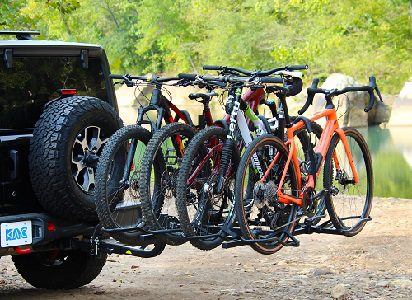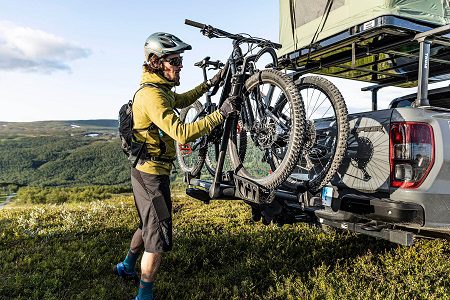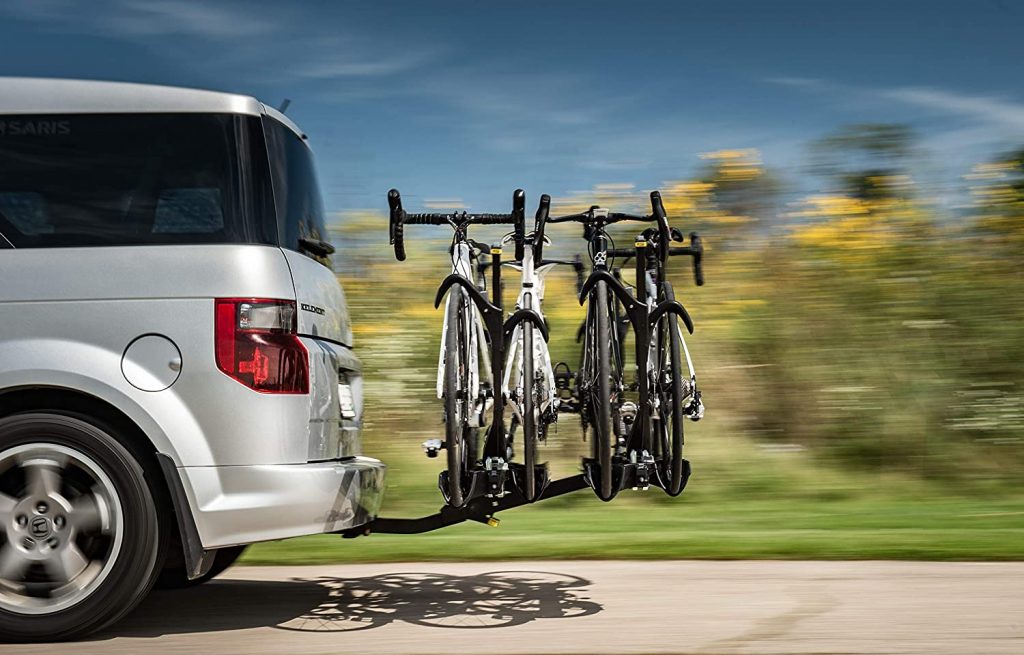
The KAC K4 Sport Hitch Bike Rack is presented as a versatile solution for transporting a variety of bicycles, including standard, fat-tire, and electric bikes. Designed for vehicles with a 2-inch hitch receiver, this rear-mounted carrier aims to provide a robust and convenient way to bring your bikes along for any adventure. With a weight capacity of 60 lbs per bike, it caters to a broad spectrum of cyclists.
Understanding Hitch-Mounted Bike Racks
Before diving into the specifics of the KAC K4, it’s essential to understand the context of hitch-mounted bike racks. These racks have become a popular choice for transporting bikes due to their stability, ease of use, and generally higher weight capacities compared to other types like trunk-mounted or roof-mounted racks.
Types of Hitch Racks:
-
- Platform Racks: These racks, like the KAC K4, hold bikes by their wheels, providing a stable platform and avoiding contact with the bike’s frame. This is particularly advantageous for e-bikes and bikes with delicate frames.
- Hanging Racks: These racks suspend bikes by their top tubes. While often more affordable, they may not be suitable for all bike types, especially those with step-through frames, and can sometimes lead to bike-to-bike contact.
Hitch Receiver Classes: Hitch receivers come in different classes (I, II, III, and IV), each with varying weight and tongue weight capacities. It’s crucial to match the bike rack to your vehicle’s hitch class to ensure safe operation.
In-Depth Look at the KAC K4 Sport Hitch Bike Rack
The KAC K4 is a platform-style hitch rack, designed to carry up to 4 bikes.
- Versatile Bike Compatibility: A key selling point of the KAC K4 is its ability to accommodate a wide range of bike types.
- It handles standard bikes effectively.
- It’s designed to carry fat bikes with tires up to 5 inches wide, catering to the growing popularity of off-road cycling.
- It can also transport e-bikes, which are becoming increasingly common for both commuting and recreation. However, it’s critical to verify the weight of your e-bike, especially with the battery, to ensure it doesn’t exceed the rack’s 60 lbs per bike limit. Removing the e-bike’s battery is often recommended to reduce weight and protect the battery during transport.
- Sturdy and Durable Construction: The KAC K4 is constructed from steel tubing, emphasizing its strength and ability to withstand the stresses of transporting multiple bikes.
- Anti-Wobble System: A patented anti-wobble system is incorporated to minimize movement of the rack within the hitch receiver, reducing sway and enhancing stability during travel. This is crucial for both the safety of the bikes and the handling of the vehicle.
- Paint Protection: The rack features foam-padded hooks to secure the bikes while protecting their paint finish from scratches and abrasions. This demonstrates attention to detail in preventing damage to your valuable cycling equipment.
- Easy Rear Cargo Access: The tilt feature allows users to lower the rack (even with bikes loaded) to access the vehicle’s rear cargo area. This is a significant convenience, especially on road trips.
- Collapsible Design: The rack can be folded down when not in use, reducing its size and making storage easier. This is a valuable feature for those with limited storage space.
Specifications in Detail
- Hitch Receiver Size: Designed exclusively for 2-inch hitch receivers. This is a common hitch size, but it’s essential to confirm your vehicle’s hitch size before purchasing.
- Bike Capacity: Carries a maximum of 4 bikes.
- Weight Capacity: 60 lbs per bike. This is an important consideration, especially for e-bikes, as mentioned earlier.
- Maximum Tire Width: Accommodates tires up to 5 inches wide, making it suitable for most fat bikes.
- Rack Weight: 79 pounds. The rack’s substantial weight is a factor to consider for handling and installation.
Installation and Assembly
The KAC K4 is designed for relatively straightforward assembly, with most of the platform pre-assembled. The primary installation step involves securely attaching the hitch tube to the vehicle’s hitch receiver. While the process is generally manageable, the rack’s weight may necessitate assistance during installation.
Important Considerations and Potential Drawbacks
- Bike Capacity Limitation: The KAC K4 is designed for 4 bikes and cannot be configured to carry fewer. This might be a limitation for those who sometimes need to carry only 2 or 3 bikes.
- Size Compatibility: The rack is not recommended for bikes with wheels smaller than 24 inches. This excludes some children’s bikes and smaller-framed bikes.
- Weight: The rack’s weight (79 lbs) can make it cumbersome to handle, install, and store.
- Handling When Loaded: The manufacturer recommends assistance when tilting the rack with bikes loaded due to the combined weight.
Safety and Best Practices
Regardless of the bike rack you choose, adhering to safety best practices is paramount:
- Regular Inspections: Before each trip, inspect the rack, hitch connection, bolts, straps, and locking mechanisms to ensure everything is secure.
- Weight Distribution: Load bikes evenly on the rack, distributing the weight as balanced as possible.
- Increased Vehicle Length: Remember that the rack and bikes add to the overall length of your vehicle, requiring extra caution when maneuvering, parking, and turning.
- Reduced Visibility: Be aware that the rack and bikes may partially obstruct your rear visibility.
- Obey Local Laws: Familiarize yourself with local regulations regarding bike rack usage, including any restrictions on license plate visibility or lighting requirements.
Comparison with Alternatives
To provide a more balanced perspective, it’s helpful to compare the KAC K4 with other popular hitch-mounted bike racks:
- Thule T2 Pro XT/XTR: A premium platform rack known for its robust construction, ease of use, and compatibility with a wide range of bike types. It often comes at a higher price point but offers features like no-frame contact and integrated security.
- Yakima HoldUp: Another strong competitor in the platform rack category, known for its user-friendly design and ability to expand to carry up to 4 bikes with an add-on.
- Kuat NV 2.0: A stylish and feature-rich platform rack often praised for its integrated repair stand and high-quality construction.
A detailed comparison table would be beneficial to highlight the pros and cons of each model.
Conclusion
The KAC K4 Sport Hitch Bike Rack presents a compelling option for cyclists seeking a versatile and sturdy way to transport their bikes. Its ability to handle various bike types, including fat bikes and e-bikes, is a significant advantage. However, potential buyers should carefully weigh its limitations, such as its weight, fixed 4-bike capacity, and size restrictions, against their specific needs and priorities. By considering these factors and comparing it with alternatives, cyclists can make an informed decision and choose the best bike rack for their adventures.

